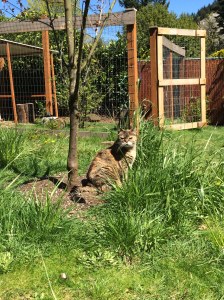Our first glimpse into the condition of our soil was when we began digging post holes for the chicken run before we moved in. Granted, it was the middle of August when all was hot and dry, but still, it was 2 full days of digging in hard pan, dry, rocky clay that appeared to be completely devoid of nutrients. Any plants that were on the property, were entirely surrounded by weeds and grass and seemed to be struggling. The one fruit tree, a pear was (and is still) infected with a fungal disease and the pears have scab. There was a serious lack of soil fertility. We had brought several plants with us from our rental house. One ornamental (or so we thought) plum tree, a cherry tree and several ornamentals such as hydrangea, lilac and spirea. We planted them in the soil and crossed our fingers that they would survive. All but a couple of plants survived the transplanting.
Soil fertility is our number one goal at this point. Even beyond grass removal, building the fertility of the soil is the key to growing healthy plants and trees. Because we are adhering to a no-till permaculture system, the focus is on building soil on top of the existing ground. We have put aged manure over all of the sheet mulched beds, covered them in straw and wood chips. In the one year since we began, we have seen a significant improvement in the soil health. An easy if you’re soil fertility is improving is the amount of soil life you see when you pick up a handful. In a handful I picked from the herb bed a few days ago, the soil was literally crawling with insects and even a couple of worms, it was moist and dark and loose, all great indicators that we’re moving in the right direction.
One of the ways we plan on building soil is with compost. We have 1 bin that is about 4 weeks old and should be ready for use soon and a second bin to which we are still adding food scraps and straw from the chicken run. Because we haven’t been able to really use any compost yet, I have been adding mulch to the base of individual plants that seem in need of extra protection and nutrients. Instead of being able to cover each planting bed completely with mulch, I will add a scoop or two of straw from the chicken run and top that with wood chips or manure. This is working great so far, but in the fall, we’ll be collecting leaves from around the city and adding them to all of our beds and compost bins.

